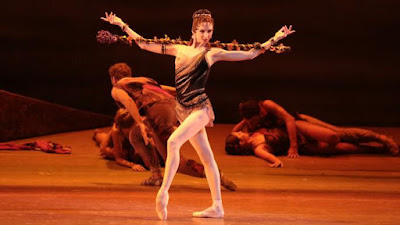Three years ago I found that while I could not fault them for their technical skills and strong technique, I found the actual productions singularly lacking in any emotional pull at all; it is disheartening to say that some things never change as I felt exactly the same about SPARTACUS.
Aram Khachaturian composed the stirring and emphatic score in 1954 and received a Bolshoi premiere in 1958 but this production is from the 1968 reworking by Yuri Grigorovich. It is hugely popular within the company as it provides a good showcase for two male dancers playing the roles of Spartacus the rebel gladiator and nasty Crassus the Roman consul.
It was a very strange experience watching it as it's a production that demanded to be thrilled over but so many aspects of it jarred. Maybe I went in expecting some idea of the Kubrick film but it really wasn't all that spectacular! The splendour of Ancient Rome was reduced to some basic painted backdrops and a few lumpy rocks and the costumes for the two lead females suggested little more than a Minsky's burlesque routine.
Grigorovich's choreography was... well, like it was hewn from stone. The Romans marched from one stage of the stage to the other in strict Martial time while the rebels ran around in circles, stopping every so often leaving a diagonal aisle for Spartacus to do running leaps from one corner of the stage to the other. There was an interesting minimal, undulating dance for the Courtesans but soon it was back to the marching and running.
The female leads were Eleanora Severard as Spartacus' 'sweetheart' Phrygia and Yulia Stepanova as Aegina, Crassus' courtesan and, while obviously talented, gave strictly two dimensional performances. This is again down to the choreography which gave them pretty shapes and nothing else - the pas de deux between Denis Rodkin's strapping Spartacus and Severard were truly odd, there was no real emotion between them just demonstrations of Rodkin's strength as he lifted Severard up by one hand, walked around with her lying down his back upside down and leaving the stage draped around him like a shawl. To be honest, the most exciting part of their dances together is that their Adagio music was used as the theme for "The Onedin Line"!
Again Stepanova struck some seductive shapes as the depraved Aegina but considering some of the scorching eroticism seen on the same stage in Kenneth MacMillan's ballets, she came across as a fairly camp vamp. Artemy Belyakov was in outrageous stampy form as the nasty Crassus - indeed his first scene, wheeled on in a chariot, sees him stamping his feet to the beat of the music which didn't so much suggest an all-conquering hero as a petulant toddler. Grigorovich also does him no favours at the start of the third act where Crassus is raging at Spartacus' successes. he literally has him leaping up and down in rage like an Imperial Daffy Duck. However what Artemy can do is spin very fast and stop dead still, so he does this again and again. And again. And again.
Denis Rodkin looks like a dancing Chris Hemsworth as Spartacus - he might be a slave but he has full-bodied hair - and didn't so much dance as strike dynamic poses. like Belyakov he too had a signature move of running and leaping, running and leaping so we got lots of that too. As I said he is obviously a powerful dancer but with no depth what can you do these days?
Oddly enough, the end of the ballet gave us three stark moments of what might have been - the Roman soldiers captured Spartacus' army from both sides of the stage, marching in ominous time to the strident solitary beat of the percussion like advancing chess pieces on either side of a chess-board; Spartacus was lifted high on Roman spears, spotlit from above on a darkened stage, and similarly, ended the ballet raised up on the hands of the masses with Phrygia mourning him. The stark black and white imagery finally gave one something to genuinely applaud; a special mention to Mikhail Sokolov's lighting design.
I wonder if I have now had my fill of the Bolshoi? I suspect I just might have...









No comments:
Post a Comment